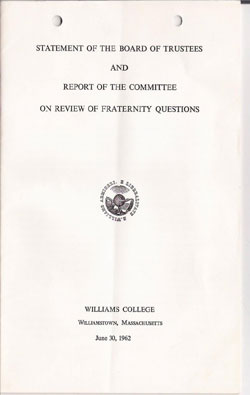Elimination of fraternities
A more complete overview of this issue can be found in the 2003 thesis of Robinson A. Sawyer, titled The Elimination of Fraternities at Williams College. All historical documents linked below have been provided by David C. Phillips.
On June 30, 1962, the Committee on Review of Fraternity Questions (informally known as the Angevine Committee, after its chairman Jay B. Angevine) submitted its report to the Board of Trustees, urging that the college assume responsibility for providing room and board to the entire student body. Up to this time, the roll had been filled by the extensive system of fraternities at the college. But mounting concerns over the effect fraternities were having on the social life of the college had led to the formation of the Angevine Committee in the fall of 1961. The complete report can be found here. A New York Times article from the days immediately following the report's publication summarizes the recommendations.
A Standing Committee was appointed by the Board of Trustees in order to help implement the recommendations of the Angevine Committee. The Standing Committee solicited the help of several Williams alumni, including David Phillips. A partial record of their correspondence is below:
Letter from the Standing Committee to David Phillips, 10/2/1962
David Phillips' reply to the Standing Committee, 10/16/1962
Second letter from the Standing Committee to David Phillips, 10/16/1962
At their meeting in October, 1962, the Board of Trustees drafted a statement addressing the Angevine Report. This statement was published with the First Report of the Standing Committee, which outlined their plan for implementing the transition away from the fraternity system. A letter to David Phillips from Vince Barnett, former Williams professor and Colgate President, illustrates how significant this issue was to the Williams community at the time.
Reaction to the Angevine Report and the Standing Committee's implementation of it varied considerably. Several Williams fraternities together published a counterargument titled A Report to the Williams College Family Containing Additional Information and Some Alternative Views on the Williams Fraternity System. The Sigma Phi Society published these resolutions in response to the report. Among the most vocal defenders of the fraternity system were the Williams Alumni Action Committee. Their three letters below span the period when the controversy was at its height:
Letter from the Williams Alumni Action Committee, 11/7/1962
Letter from the Williams Alumni Action Committee, 9/24/1963
Letter from the Williams Alumni Action Committee, 1/14/1964
The tactics of the Williams Alumni Action Committee, in particular their urging of alumni opposed to the Angevine Report to withhold their contributions to the Alumni Fund, angered some members of the Williams community. Daniel K. Chapman, President of the Society of Alumni of Williams College, wrote this letter in December, 1962. Following the second letter of Williams Alumni Action Committee, David Phillips wrote this response.
Despite the protests of many alumni and students, the Board of Trustees reiterated their commitment to acting on the recommendations of the Angevine Committee in a letter sent to alumni on January 28, 1963.
